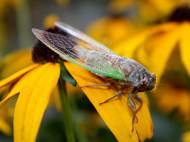Bionics| Featured»
Antibacterial power of black silicon inspired by cicada wings
 Earlier this year, we reported about a finding which revealed that physical structure of Psaltoda claripennis cicada wings can shred certain types of rod-shaped bacteria. After analyzing the surface, researchers at the Swinburne University of Technology used biomimicry to create a surface with similar properties. This nanosurface could lead to development of a new generation… »
Earlier this year, we reported about a finding which revealed that physical structure of Psaltoda claripennis cicada wings can shred certain types of rod-shaped bacteria. After analyzing the surface, researchers at the Swinburne University of Technology used biomimicry to create a surface with similar properties. This nanosurface could lead to development of a new generation… »










